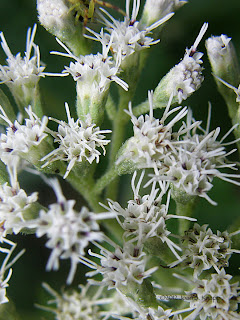September 1st, 2012. It
was the Labor Day (US) holiday weekend so we took the opportunity to make an
overnight trip into the Chattahoochee National Forest. After leaving Dockery
Lake, we drove further up GA-60 to the Coopers Creek Wildlife Management Area.
There was a seep somewhere uphill of the turn-off that created a permanent flow
of water beside the road. We found quite a variety of wildflowers just at the
turn-off onto Cooper Creek Road.
Trifolium pratense (Red Clover)
Red clover is still a favorite with
its delicately colored florets. It was growing by the road in many areas.
Eutrichium fistulosum (Trumpetweed,
Joe Pye Weed, Hollow-stem Joe Pye Weed)
These plants were 8 to 9 feet tall and common
along roadsides in the area
Lobelia
puberula (Downy Lobelia, Hairy Lobelia)
These
plants seem to have been ubiquitous along roadsides for the last couple of
months.
Eupatorium
perfoliatum (Common Boneset, Boneset)
We
found a few of these plants; they were about 3 to 4 feet tall
Impatiens capensis (Jewelweed, Spotted Jewelweed, Spotted Touch-me-not, Orange Jewelweed,
Orange Touch-me-not)
These
were impressive plants about 6 feet tall
Lycopus
virginicus (Virginia Water Horehound)
These
were short plants, about 2 feet tall. It would be easy to overlook them
Vernonia noveboracensis (New York Ironweed)
These plants were also enjoying the moisture.
They were about 6 to 7 feet tall.
Next: More wildflowers in the Coopers Creek Wildlife Management Area
Click on an image to view a larger image
Identification
resources:
Southeastern
Flora:
- Impatiens capensis (Jewelweed)
Native and Naturalized Plants of the Carolinas
and Georgia:
- Lycopus virginicus (Virginia Water Horehound)Illinois Wildflowers: Eupatorium perfoliatum (Common Boneset)
Distribution:
United
States Department of Agriculture Plants Database:
- Eutrichium fistulosum (Trumpetweed)
- Impatiens capensis (Jewelweed)
- Vernonia noveboracensis (New York Ironweed)






























































